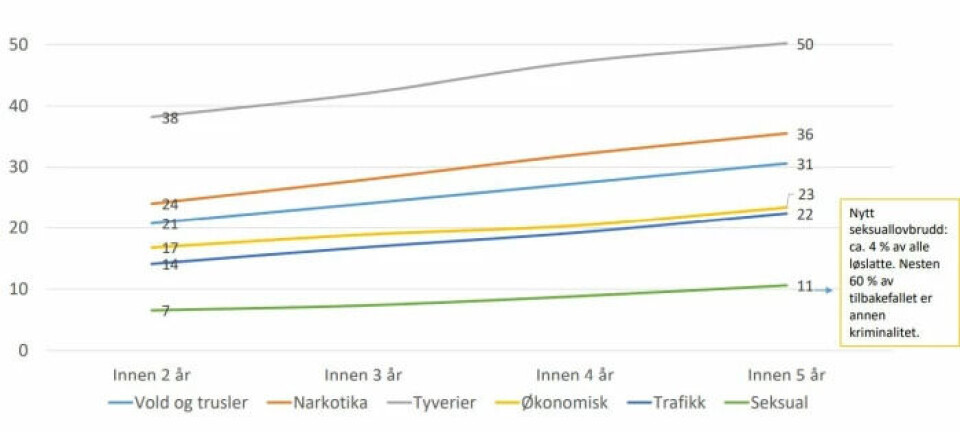
The number of sex offenders serving time in Norwegian prisons has doubled
The road back to society is difficult: “I can't get a job and I feel like I'll never finish serving time”, says a former convicted sex offender.
“Everyone thinks I should go back to work, but no one wants to hire me. And employers think everyone else should take that responsibility.”
ScienceNorway.no meets a former sex offender at the Norwegian 'Tilbakeføringskonferansen', a conference about finding one’s way back into society after serving time in prison.
The man has served a sentence of one year and eight months for downloading sexualised images of minors.
He agrees to an interview with ScienceNorway.no to talk about his experience. ScienceNorway.no has complied with his wish to remain anonymous.
The man says that he has been open about his case when asked why he has gaps in his CV. He says he does not get called for job interviews.
“When I ask why I’m not an acceptable candidate, I’m told that my presence would be too burdensome. They don't want to take a chance, because of a lack of trust among the employees and a perceived risk to their business reputation,” he says.
More sex offenders
The man believes this attitude exists because the media and the police portray dealing with sex offenders as dangerous.
“Even though the rate of previously convicted criminals who reoffend and reenter the prison system is very low among people who’ve been convicted of sexual offences, the fear of employing people like me is rooted in their belief that the risk of reoffending is high,” he says.
There are more and more people like this man. The number of sex offenders serving time has doubled in Norway the last eleven years.
The proportion of inmates serving time for sexual crimes in Norway has also increased: in 2010, only one in ten inmates was convicted of rape or other sexual offences. By last year, the proportion had increased to 27 per cent, much higher than in the rest of the Nordic region.
Almost one in three
“The proportion is as high as 30 per cent in some months,” said researcher Ragnar Kristoffersen in his lecture at the recent conference.
The conference was held under the auspices of the Oslo Red Cross’ network after being released from prison. It brought together researchers and employees within the correctional system for knowledge exchange. This year’s theme was: ‘Sex offenders: Convicted and condemned?’
In the last eleven years, the number of people convicted of rape and other sexual offences in Norway has risen. Most receive a custodial sentence or preventive detention.
Just under 400 convicts were imprisoned for immorality offences in 2010; in 2021 the number had risen to just over 800.
So what accounts for this increase?
More acts are considered rape
The increase in the proportion of people in prison for sexual offences is linked to a change in Norwegian law in 2010.
The sentencing for rape was increased, and several criminal acts are now considered rape, Kristoffersen said. He is a researcher at the University College of Norwegian Correctional Service (KRUS).
On average, individuals who commit sexual crimes receive two-year prison sentences. For those convicted of rape, the minimum sentence is three years and the average sentence is four years.
“The increase in new prisoners to serve time is stable. The long sentences are what increase the pressure on space in the prisons,” says Kristoffersen.

Won’t ever finish serving time
The man interviewed by ScienceNorway.no was featured in a film at the conference.
“I can't get a job and I feel like I'll never finish serving time,” he says. In the film, he says that no one is willing to take the chance of giving him a job. He is well educated and has solid experience.
“I did something really stupid, and I’ve completed my sentence. But it feels like I’m still being punished,” he tells ScienceNorway.no after the conference.
Low recidivism rate
The risk of reoffending and reentering the prison system, also known as recidivism, is low for this group compared to other offences, says researcher Kristoffersen.
Individuals convicted of theft have the greatest risk of recidivism. Half of them will be re-sentenced within five years.
Drug convicts have a recidivism rate of 36 per cent, followed by crimes involving violence and threats, traffic offences and economic crime.
Eleven per cent of convicted sex offenders reoffend. Only four per cent of all released persons are punished for a new sexual offence.
Almost 60 per cent of the recidivism for this group is therefore due to crimes other than new sexual offences.
Feeling condemned
Nevertheless, many former sex offenders struggle to re-enter society.
Many feel condemned, even though they have completed their sentence.
The previously convicted interviewee believes excluding sex offenders is a problem we need to talk about. For the time being, he is living on unemployment benefits.
“If society wants us to be brought back into society once we’ve completed our sentences, we have to be given the opportunity to work again,” he says.
More sexual offences are being reported
The increase in inmates serving time for sexual offences is also linked to the fact that more and more people are reporting sexual offences.
Just over 4000 individuals were reported for sexual offences in Norway in 2010, compared to around 8000 last year.
While reports for other offences have decreased over the last eleven years, reported sexual offences have doubled.
People reported for economic crime and other violence and crime fell by 30 per cent in the same period.

Most sex offenders convicted of rape
Most of those sentenced for sexual offences – 42 per cent – received some form of rape conviction.
“This is due to the expanded definition of rape, where online abuse and exploitation also comes under the rape clause,” Kristoffersen explains.
The rest were convicted of other types of sexual offences, such as sexual intercourse with 14 and 15 year old minors, sexual acts, superior-subordinate sex, sexually offensive behaviour or attempted rape.
The remaining 30 per cent consist of other or unspecified sexual offences, according to Statistics Norway.
Online rapes punished just as harshly
Kristoffersen finds it strange that online rape – forcing somebody to perform sexual acts on themselves online against their will – is punished as harshly as rape where physical force is used.
This practice poses a problem for the sense of justice and respect for the penal system, according to Kristoffersen. He believes it is important that the penalty levels between different offences reflect their severity and are in a proportional relationship with each other.
He has attempted to start a debate about the level of punishment for rape and other sexual offences in Norway.
Kristoffersen and forensic psychiatric expert and psychology specialist Pål Grøndahl have been critical of judging online assault as harshly as physical rape in an opinion piece (link in Norwegian) published in Norway’s largest printed newspaper, Aftenposten.
For example, imposing the same punishment for online rape as for murder and dismemberment is unreasonable, they state in another comment in Aftenposten (link in Norwegian).
Problem for legal certainty
In an article in the Norwegian legal journal Lov og Rett, district judge Rune Bård Hansen in the Agder Court of Appeal is also critical of the punishment level in a number of sexual offences.
He asks why a man who fingered a woman once was sentenced to two years and nine months in prison, while a woman who used her position in the Norwegian Labour and Welfare Administration (NAV) to have sex with an asylum seeker several times, and who accused him of rape, received a sentence that was 18 months less.
Kristoffersen believes that sentencing practices in some sexual matters challenge legal certainty.
“Some individuals receive rape sentences of 15 years, which is the same as the average for murder. I think this is completely unreasonable and a problem for legal certainty,” he says.
References:
Ragnar Kristoffersen: Correctional Statistics of Denmark, Finland, Iceland, Norway and Sweden 2016 – 2020. University College of Norwegian Correctional Service, 2022.
Nina Schmidt: Etterlyser bred debatt om straffenivåene i seksuallovbruddsaker. [Calls for broad debate on the levels of punishment in sexual offence cases.] Advokatbladet, 20 April 2022. (in Norwegian)
———
Read the Norwegian version of this article at forskning.no

































